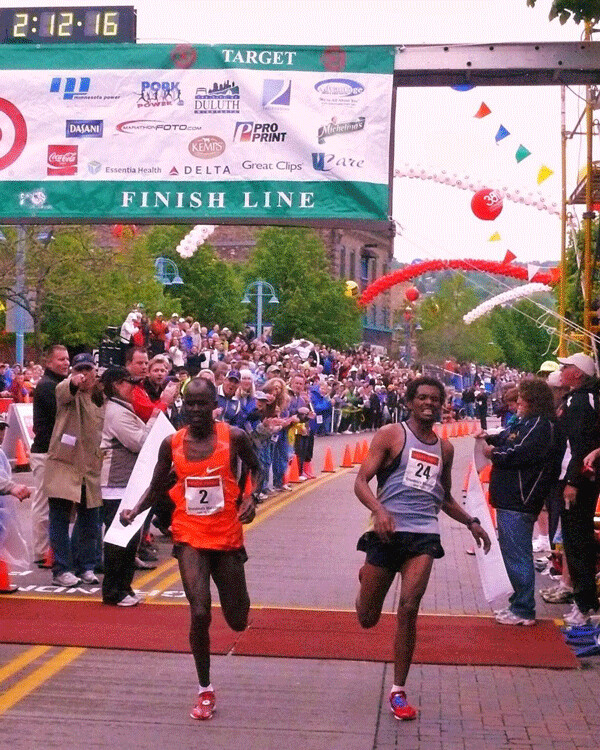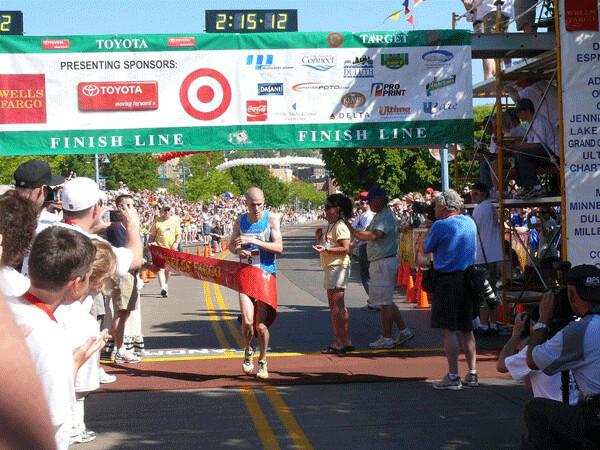News & Articles
Browse all content by date.

At the finish line, back in 2011, we were all waiting for what we anticipated might be one of the closest finishes in Grandma’s Marathon history. We had heard reports that the front two were running in tight competition. But none of us knew just how close.
As the leading pair of runners made the final turn and had only the straight sprint to the finish, Christopher Kipyego of Kenya passed leader Teklu Deneke of Ethiopia and broke away by a few strides. With adrenaline pushing both East African runners, they sped toward the crowd at the finish line.
It appeared Kipyego would win by about five strides, but about 20 yards from the finish, he suddenly pulled up. He explained later that he saw markings, which turned out to be in place for the timing mechanism, and mistook it for the finish. In an instant, he realized his mistake and took off again. But even after 26.2 miles, momentum was vitally important, and as Kipyego tried to dash for the finish, Deneke pulled up alongside him.
If you can picture it, with two strides to go, Kipyego was still one stride ahead; and two strides past the finish line, Deneke had passed Kipyego by a stride. And precisely at the finish?
Kipyego’s left shoulder hit the finish banner as his left foot crossed the line, a millisecond ahead of Deneke.
Actually, not a millisecond, but more like two-tenths of a second. Kipyego’s winning time was, officially, 2:12:16.36, to Deneke’s 2:12:16.56. That was the 2011 race, and it easily stands as the closest finish in the 41 years of first Minnesota’s and then the world’s elite runners revisitng Highway 61 from Two Harbors to Canal Park in Duluth.

The previous record for the closest finish was 4 seconds, but one full second would have seemed like a lot to either runner that day. Digging through the photos I’ve shot over the past 20 years or so of watching and writing about Grandma’s Marathon rekindled the breathtaking finish of that race. In fact, I love the expressions on the faces of the people in the background of that photo, as they could hardly believe their eyes at the drama at the completion of the race.
There have been many other eventful Grandma’s runs, but that one stands out, as we approach this Saturday’s 42nd annual running of the race, which has evolved to an event that attracts a group of 20 or 30 true elite runners, mostly from Kenya, and then about 8,200 more men and women who just love to run marathons.
With 8,231 participants registered, and 9,284 more registered for the Garry Bjorklund Half Marathon, and 2,370 entered in the Friday William A. Irvin 5K run, a controlled total of over 19,000 runners will be in Duluth to compete in Grandma’s.
It has become the 11th largest U.S. marathon, and while Minnesotans annually migrate to Duluth to enjoy the scenic run down the North Shore of Lake Superior, nearly everyone not from Minnesota, who runs Grandma’s, comes back because they find it possibly the most welcoming, enjoyable and scenic ways to run 26.2 miles.
Living near the North Shore, it’s a natural be drawn to the race, and as a media person, writing about it always is an adventure and a fulfilling task. I have driven up the North Shore, shooting last year as the early lead group ran down the hill and into Knife River from the east, and then driving hastily to Duluth to get set up in time for the finish.
I also gambled a couple of times on shooting the leaders as they ran down the cobblestones of Superior Street and into the business district of downtown Duluth, then hustled to fight the crowd and beat the leaders to the finish line. Sometimes it works.

As for other highlights among the 41 previous finishes was the 2009 run. In 2008, the lead group of a dozen or so East Africans had an interloper among them. Amid all those lean, black bodies was a taller, larger white guy. It was Christopher Raabe, listed as being from Washington, D.C., where his family had moved, although he grew up in Sauk Rapids, Minnesota and attended North Dakota State University. He finished sixth, meaning the top dozen finishers consisted of 10 from Kenya, one from Ethiopia, and one from Sauk Rapids.
Lamech Mokono, from Kenya, won that race. But the next year, 2009, Raabe came back, having intensified his training to do just a little bit better than in 2008. He surprised himself, he said, when he was able to stay with the leaders when the top half-dozen broke away. Coming down Superior Street, he was further surprised when he felt good enough to make a move on the leader and take the lead himself. Glancing back, he expected to see several runners moving up to challenge him, but instead he saw nobody.
It was Raabe’s third Grandma’s, and only the sixth marathon he had ever run, but he ran a bersonal best 2:15:13 and won that 2009 Grandma’s — the first Minnesotan to win it since 1982, when Dick Beardsley won.
Beardsley, of course, had run an epic 1981 Grandma’s, unseating Twig native Garry Bjorklund, who had won in 1980. Those events are inextricably linked in Grandma’s lore, because Bjorklund had won that 1980 race — the fourth Grandma’s — with a 2:10:20 time. So in 1981, when Beardsley and Bjorklund hooked up in a two-man race, Beardsley gained a slight lead and went all-out to hold off Bjorklund, thinking his fellow-Minnesotan was making a finishing surge.
He wasn’t, but the incentive pushed Beardsley to win in 2:09:37, the fastest time in the first five years of Grandma’s. In fact, it was the fastest time until four years ago, when Domonic Ondoro of Kenya won in 2:09:06, shattering a homestate record that had stood for 33 years.
Slim, aerodynamic, and swift as the hundreds of Kenyans have been, it took 33 years before any of them could break Beardsley’s record. His mark still stands as second fastest, and Bjorklund’s 1980 winning time is third fastest. How far have we come, after all?
That brings us up to the present, when we will get to see if Elisha Barno, a 32-year-old Kenyan, can win his fourth consecutive Grandma’s Marathon. He won last year in 2:12:06, for the first “threepeat” of the event.
Hellen Jepkurgat, 37, also of Kenya, won the women’s marathon at 2:32:09 last year, and she, too, is back to defend her title.
The homecomings, and the record-seeking, and the age-group competition, are all fun. Plus the 5K, and the half-marathon, which now outnumbers full-marathon entrants, and is where Duluthian Kara Goucher will participate in her return from her adopted Colorado for the weekend to the place that helped launch her to national and Olympic fame — all are reasons to be attracted.
For me, I’d just like to see a close race. Maybe even a victory by, say, one-tenth of a second.
| Tweet |


